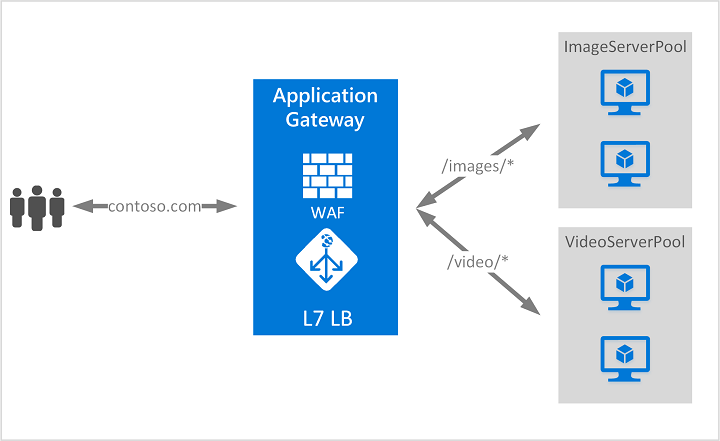Azure Application Gateway: A Journey into Seamless Application Delivery
 Sumit Mondal
Sumit Mondal
Introduction
In the ever-evolving landscape of cloud computing, businesses are continually seeking innovative solutions to enhance their application delivery, scalability, and security. Azure Application Gateway stands tall as a beacon of efficiency, providing a robust platform for managing and optimizing web traffic. In this blog post, we will delve into the intricacies of Azure Application Gateway, exploring its features, benefits, and even embarking on a hands-on example to demonstrate its prowess.
Understanding Azure Application Gateway
Azure Application Gateway is a fully-managed application delivery controller (ADC) that enables efficient and secure distribution of network traffic to various services. It serves as a gateway that optimizes web application delivery while ensuring high availability, scalability, and enhanced security.
Key Features:
Load Balancing: Azure Application Gateway excels at distributing incoming traffic across multiple servers to ensure optimal utilization of resources. It supports various load-balancing algorithms, including round-robin and least-connections, providing flexibility based on application needs.
SSL Termination: With built-in SSL termination capabilities, Azure Application Gateway can offload SSL/TLS encryption, reducing the computational burden on backend servers. This not only enhances performance but also simplifies certificate management.
Web Application Firewall (WAF): Security is paramount, and Azure Application Gateway incorporates a Web Application Firewall to protect against common web vulnerabilities. It provides robust defense mechanisms, including SQL injection and cross-site scripting prevention, shielding your applications from potential threats.
Session Affinity: Ensuring a seamless user experience, Azure Application Gateway supports session affinity, directing subsequent requests from the same client to the same backend server. This is particularly beneficial for applications that require consistent user sessions.
Path-Based Routing: Tailoring traffic distribution based on specific URL paths is made easy with path-based routing in Azure Application Gateway. This feature allows for efficient management of diverse applications hosted on the same set of backend servers.
Hands-On Example: Setting up Azure Application Gateway
Let's embark on a hands-on example to showcase the simplicity and power of Azure Application Gateway.
Scenario: Imagine you have a web application with multiple backend servers, and you want to ensure optimal load balancing and SSL termination for enhanced security.
Step 1: Create a Resource Group
In the Azure Portal, create a new resource group to organize your resources efficiently.
az group create --name MyResourceGroup --location EastUS
Step 2: Deploy Backend Servers
Set up a simple web application on multiple virtual machines to simulate backend servers.
Step 3: Configure Azure Application Gateway
Now, create an Azure Application Gateway within your resource group. Specify the backend pool, configure listeners, and enable SSL termination.
az network application-gateway create --name MyAppGateway --resource-group MyResourceGroup --capacity 2 --sku WAF_v2 --http-settings-cookie-based-affinity --frontend-port 80 --http-settings-port 80 --http-settings-protocol Http
Step 4: Add Backend Servers to the Pool
Associate your backend servers with the created application gateway.
az network application-gateway address-pool create --gateway-name MyAppGateway --resource-group MyResourceGroup --name MyBackendPool
Step 5: Configure SSL Certificate
For SSL termination, upload your SSL certificate to the application gateway.
az network application-gateway ssl-cert create --name MySSLCert --resource-group MyResourceGroup --gateway-name MyAppGateway --cert-file /path/to/your/certificate.pfx --cert-password YourCertPassword
Step 6: Update Listener
Update the listener to use the SSL certificate for secure communication.
az network application-gateway http-listener update --name MyHttpListener --resource-group MyResourceGroup --gateway-name MyAppGateway --frontend-port 80 --frontend-protocol Https --ssl-cert MySSLCert
Step 7: Test Your Setup
Navigate to the public IP address associated with your application gateway to access your web application. Observe how Azure Application Gateway efficiently distributes traffic among backend servers while ensuring SSL termination.
Conclusion
Azure Application Gateway emerges as a formidable solution for businesses seeking to optimize their web application delivery. Its comprehensive features, including load balancing, SSL termination, and Web Application Firewall, make it a versatile tool for ensuring performance, scalability, and security. As demonstrated through our hands-on example, setting up and configuring Azure Application Gateway is a straightforward process, empowering businesses to embrace a seamless and secure application delivery experience in the Azure cloud.
Subscribe to my newsletter
Read articles from Sumit Mondal directly inside your inbox. Subscribe to the newsletter, and don't miss out.
Written by

Sumit Mondal
Sumit Mondal
Hello Hashnode Community! I'm Sumit Mondal, your friendly neighborhood DevOps Engineer on a mission to elevate the world of software development and operations! Join me on Hashnode, and let's code, deploy, and innovate our way to success! Together, we'll shape the future of DevOps one commit at a time. #DevOps #Automation #ContinuousDelivery #HashnodeHero